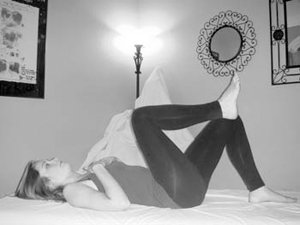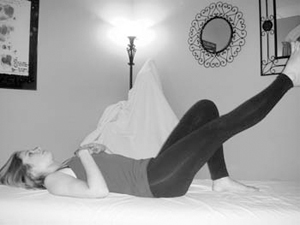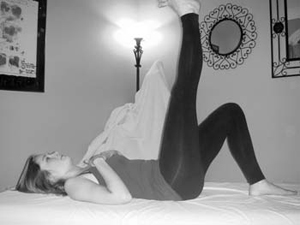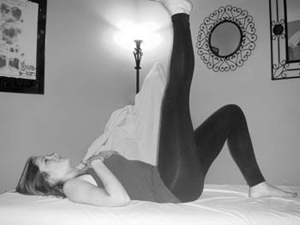CASPARI, Monica / MARTINE, Jon / EASON, Libby
Publication: Structural Integration / Language: English
Date: 03-2009 / Vol: 37 / Issue #: 1 / Page: 3-5
Question: In the fitness world the concept of “core strength” is often mentioned as a benefit of certain exercise regimens. Please compare and contrast the concept of core strength /stability from a Rolfing perspective and from a more mainstream fitness perspective.
Answer: Core as an Event in Time
A Rolfing practitioner must be comfortable with phenomena that are always shifting, always moving. This is what makes things tough. Those few people who can build a body up are the few who have sensitivity to a sense of security in insecurity. We’ve really given “The Wisdom of Insecurity” a physical component. When you come right down to it, that wisdom of insecurity explains what Rolfing practitioners are talking about—it’s the body’s need for quick adaptation.
Let us start first by defining what is the “core.” From a structuralist point of view, core is often defined as the “visceral space” that goes from the pelvic floor to the roof of the mouth/nasal cavities. In this sense it is a “place,” a geographical something (that as structuralists we want to “organize” through our unique kind of touch). Yet from a functional point of view, core is an “event,” something that happens in time— if and when we get the right coordination between the muscles that stabilize the system, then the muscles that give it strength, and then the muscles that give it speed. It is a gestalt: either you have it or you do not have it. It depends on a certain way of relating to the substratum and to space through the senses. We call the use of the senses “perception.” Coordination and perception are the two sides of the same coin. We can’t separate one from the other. When you affect one you affect the other. But because our patterns of coordination are deeply imprinted in our systems, all we can do to build core strength/stability is to affect the way the client perceives (uses his senses) in order to evoke the best possible coordination. And as Hubert Godard says: “Every day (and each moment) we must rebuild the world; we must rebuild ground and space.”
As structuralists we say that we want the system to move with “economy of function and grace.” What that means from the functional perspective is that we want the system to be able to have what we call “dynamic stability” so that it can then move with fluidity through space, quickly adapting to whatever stimulus evoked the movement. I like to think of the big cats: they are very stable and strong, and yet have lots of fluidity. Strength in the core does not mean rigidity in the core. If I think of “core strength” as building muscles in the sleeve around the visceral space, then I end up cutting the “melody” of the person, the flow in her movements. We end up getting rigidity around the core and less adaptability. And this is what I see the mainstream fitness perspective producing, maybe because it values the form of the sleeve muscles so much.
The mainstream emphasis is not on getting dynamic stability but on building up the sleeve muscles. Paradoxically, it focuses on the sleeve to “get the core,” while our focus is in the way the person relates to the environment—that is, to the substratum (gravity, or “down”), to space (“up”), and to other and things. In this sense we can say that our focus in building core strength/ stability is in changing the way a person uses her senses in order to get the “right” order of events—i.e., the right order of muscle firing: first the local stabilizers (the most deep muscles), and only then the more superficial (sleeve) muscles. The mainstream routine shrinks the kinesphere (the potential space for movement around a person), disconnecting the person from the environment and others, while our functional perspective relates the person to the environment.
What is interesting for me is that, like in so many other situations, we don’t need to have one or the other. We can have “this and that”—let’s say “all.” We can work structurally to “get the core,” and be guided by the functional goals of the “Recipe” to develop a dynamic stability/movement adaptability, and then go for muscle build-up. But this muscle build-up for core strength/stability that the mainstream values should take into consideration the concept of the person relating to the directions of “down/up and other/things,” meaning that a person would have to learn—as of now, from a Rolf movement practitioner — how to re-build perception before each movement using machine or floor exercises. As Dr. Rolf said (referring to the teaching and learning of Rolfing): “Your security comes only from relationships.”
Monica Caspari
Rolfing Instructor, Rolf Movement Instructor
Answer: Rolfing and the Fitness World: Complementary Approaches to Core Strength
As winter is upon us and the weather encourages me back to the gym, I once again get a glimpse into mainstream fitness. Mind you, I am in Boulder and mainstream may be different in your neck of the woods. Anyhow, if you follow the trends in exercise and fitness, you’ve probably heard the phrase “core strength.” Core strength in this context refers to the muscles of your abdomen and back and their ability to support your spine and keep your body stable and balanced. Targeting the ”strength” of these muscles has been linked in the exercise world to managing back pain and supporting functional movement.
Images of a weight-lifting belt, corset, or a wrap around the center and to the spine are common and allude to the protection and stability these structures offer. These programs typically target the external obliques, internal obliques, rectus abdominis, transversus abdominis, erector spinae and sometimes the deep multifidus. While there are exercises to target the individual muscles, it is also common to hear that these muscles must work together to function most effectively.
The exercise community, as well as Pilates and physical therapy, have benefited by the research in low back pain that has also influenced our Rolfing/structural integration perspective. Pain may be at the root of dysfunction and can be responsible for inhibiting deep stabilizers and restricting their capacity to sustain contraction. The messages from the research trickle down and hold unique interpretations as they resurface in our gyms and health clubs. While we are utilizing the same research to inform our approaches, there are some noteworthy refinements that flavor each modality as it defines “core strength.”
From the exercise perspective, depending on your “problems,” there are activities you can do to help “correct” your posture. For example, if you have an excessive anterior pelvic tilt, corrective stretching would be suggested for the hips and back and strengthening exercises would be done for the lower body and abdominals. Performing these functional exercises utilizing balls, wobble boards and other orienting challenges requires the active engagement of the core muscles. Other exercises target these muscles with weights or body weight as in a plank or side plank, where the body is held in a rigid position to reinforce core stability. These exercises are useful especially if one can maintain these high-demand challenges, but they may fall short of addressing the low-threshold contraction of joint stability.
From the Pilates perspective, change in function occurs as a consequence of repetitive retraining of movement. The exercises are carefully performed orchestrating breath, awareness, detailed muscle recruitment, proprioception and kinesthetic feedback. Intention and imagery are commonly used to invite appropriate integrative movement. Of course the skill of the practitioner will determine the focus of the work. Pilates has been recently defined by its intention, with clinical Pilates and exercise Pilates expressing subtle, yet distinct differences in intent.
Clinical Pilates may focus on restoring appropriate function disrupted by accidents or injury. The slower, staged, clinical approach may utilize more gradual enrollment of stabilizers and bring more focus on sequencing and firing of low-threshold stabilizers by enrolling the client’s awareness. The focus is on enrolling the low-threshold stabilizers prior to adding more challenge, as most everyone will access appropriate contraction with a large demand, but many dysfunctions occur when the local stabilizers do not contract to anticipate a movement or do not receive adequate stimulus to reach the threshold of contraction and assist in stabilizing under normal conditions of sitting or standing. Thus, instability leads to phasic global muscle bracing, and eventually fatigue and pain.
Afferent nervous system input influences tonic motor output. In order for the body to anticipate an action and enroll coordination to support efficient movement, an appropriate sequence of firing must occur. Rolfing, and for that matter clinical Pilates and skillful physical therapy, will offer awareness-based activities to clients that activate the appropriate afferentation (information into the system) to inform and initiate balanced stability and mobility. However, gym-style Pilates and other general core approaches may be taught by someone with a shorter training and involve deliberate movements, breathing and centering but may lack the preparatory, low-threshold stability necessary to access appropriate deep estabilizers. This may result in over-contraction and recruitment of large stabilizers instead of the deep local stabilizers.
Core activity as coordination is a potential strength of Rolfing. The invitation to utilize awareness to inform a way of being is necessary for recovery of function. Rolfing may be a missing piece that assists the client to access proprioception that feeds appropriate anticipatory stability to the deep stabilizers. We do this by mobilizing the tissue with touch to free the restrictions and then offer education to our clients to orient and appropriate gravity to their benefit. Use of imagery and a felt sense of connection to ground and space, while not unique to Rolfing, is necessary to sustained, low-threshold contraction, which is at the foundation of more gross and complex movements.
Core stability is thus less a set of muscles that are strong enough to do the job, but a synthesis of orientation, proprioceptive-driven afferentation, and retraining of the deep stabilizers and global movers to facilitate appropriate function. Awareness is key to the rehabilitation of function and the restoration of fi ring sequence and capacity to sustain contraction. Studies have shown that inhibited contraction can lead to reduced capacity to produce adequate ATP or energy in the muscles. Therefore, restoring function may require repeated low-threshold contraction as in Kegels or other simple pre-movements, which not only make the neural pathways more accessible, but retrain ATP production over time.
It seems important to investigate these other approaches and understand their strengths as we support our clients in their activities. Rolfing has developed and appropriated unique approaches to restoring function and access to core experience that can complement these other pursuits. This is especially true when there is interruption of the low-threshold contraction of deep stabilizers, as in pain and chronic imbalances.
Jon Martine
Rolfing Instructor
Answer: Core Considerations
Many people who come for Rolfing ask about exercise and the use of core muscles. Many have had training in core strength. When I ask clients to demonstrate how they access a sense of core, I usually see an overuse of sleeve musculature and fascia. I start by telling them that we have a different definition of core in Rolfing structural and functional /movement work. It can be communicated as a concept, but I prefer to give clients the experience of accessing core in a different way than their accustomed use.
I ask the person to show me how he might engage the core, lying supine and raising one leg. Most oft en what I see is the lumbars coming off the table, or being pushed posterior into the table. Many times there is a preparatory movement of tightening the abdomen. Core engagement is not happening as ideally as it could. So I ask the client to notice how he is making the movement. Then, I ask him to do this simple sequence:
1. Have the client lay supine and bring one leg up so that the foot is fl at on the table. That leg can be used for support for the next step.
2. Have the client bring the other knee towards his chest, then extend that foot toward the ceiling, reaching or pushing through the heel, while supporting with the other foot to stabilize the pelvis. Have him notice how he does this movement.
3. I then hold the heel and show him how to do this movement by lengthening through the bones of the leg, allowing the psoas/core space to stay long, and the sit bones to rest toward the table.
4. Then I ask the client to bring that leg down, keeping the extension through the heel, and staying long in front of the spine. I keep contact with his heel, with a slight suggestion to lengthen there. I place my other hand over the psoas to help him find the length, or behind the lumbars and lower ribs to allow that to rest.
5. Usually the client is very surprised at how easy it is to do this motion. There is no “scrunching” of the core abdominal space, no compression of the lumbars. The transversus abdominis is engaged, supporting the transverse processes of the lumbars, providing the ability to lengthen and distribute the reach of the leg through the rest of the core space.
6. I always remind the client to notice what he is doing with his neck. There is usually some tendency to pull in the shoulders and neck, and allowing these to rest keeps the client from adding tension here.
7. I repeat this with the other leg, asking the client to notice any difference in how the two sides feel.
8. After a few times with my contact, I ask him to find it on his own, and to play back and forth between the old pattern and the new. This anchors the new pattern, while keeping the security of the old and the space in between.
This is helpful for clients who are doing any kind of exercise. Finding length and space in the core keeps one from getting compressed during weight-lifting, provided the weights are not more than the structure is suited for. Practicing Pilates is much more effective with this different use of core. Dance, martial arts, or any movement practice are enhanced, as are everyday activities like picking up children.
Of course, the most essential element for teaching your clients a sense of accessing core is having that experience yourself. One simple way to initiate this experience (or re-establish it) is to practice finding easy motion in the psoas. Stand with one foot on something low, one or two books or a stair. Make sure there is something to hold onto with your hand, in case you lose your balance. Allow the other leg to swing gently —imagine that it is dropping, or reaching, all the way from the top of the psoas at the back of your diaphragm (the front of your spine at around T12/L1). Allow your head to be curious about the ceiling. Notice if you tend to push or pull your leg to move it. Continue the exploration until you can begin to get a feeling of ease, like nothing but gravity is doing the work. I like the image of sea plants swaying gently on the ocean floor, but use whatever image or sensation allows you freedom and fluidity in the action. Then play with the sequence outlined above, which we see demonstrated in Photos 1-4 by my office manager, Claire Anderson, whose assistance I appreciate.
Photo 1. I asked Claire to do this motion without any coaching. She tightened her abdomen, and rolled her pelvis toward the ceiling to pull her knee toward her chest. Notice the shortness from mandible through abdomen.

Photo 2. Here, Claire is using that same “sleeve” effort to hold her core, and bring her foot toward the ceiling.
Photo 3. Here, Claire has allowed her abdomen to rest, and her sit bones to sink toward the table. I lightly held her heel and gave a slight pull toward the ceiling, while encouraging her to allow her heel to be drawn upward as if being pulled by a string. Notice the difference in the shape of her mid-section, abdomen, and pelvis.
Photo 4. Claire is able to keep the length and lightness as she brings her leg down. Notice the ease through abdomen and pelvis compared to Photos 1 and 2.

Libby Eason
Rolfing Instructor


